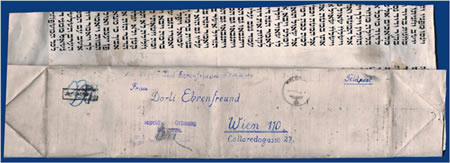Inspired by the rise of Holocaust deniers in the later 70’s, stamp collector, civil rights activist and writer Ken Lawrence began a unique collection: postal memorabilia of the Holocaust.
Over the next 30 years, Lawrence amassed 250 pieces of mail which provide a remarkable, chillingly mundane glimpse into the workaday world of the Holocaust.
His collection includes rarities like an envelope from a letter sent from Dachau in 1933, shortly after the concentration camp opened; a certified-mail receipt for a prayer book sent to a Jew in a French camp; a postal checking account receipt with a crude anti-Semitic cartoon indicating payment for a Nazi propaganda newspaper; the only known letter from Rabbi Leo Baeck, leader of German Jewry, when he was held in the Theresienstadt ghetto; cards from two previously unlisted camps in Romania; and mail sent to a Nazi doctor on trial for war crimes at Nuremberg in 1945.
Mr. Lawrence described the biblical scroll used as a parcel wrapper, which recounts part of the tale of David and Goliath, as “the most viscerally disturbing item” in the collection. “Some scholars have told me it is among the most important surviving evidence of Nazi desecration,” he said.
He’s now sold the collection to the Spungen Family Foundation in Illinois, who will continue to add to the collection while putting it on public display in the Illinois Holocaust Museum and Education Center.
If you can’t get to Illinois anytime soon, don’t fret. The Spungen Foundation has put the entire collection online. They’re not just thumbnails, either. Every wrenching postcard and notice of arrest is viewable full-size in pdf format.

The Jewish Museum Berlin has similar letters in their collections, for example this heart-wrenching correspondence. These kinds of personal stories really bring home the reality of historical events as well as providing important documentation, it’s good to see this collection being placed online.
I think that’s one of the advantages of a small collection like the Spungen Foundation’s. They can focus on each individual piece — putting them all online in fully readable form — in a way that a major institution cannot.
[…] The always excellent The History Blog this morning alerted me to a really interest project […]
What a wonderful hattip. Thank you kindly for the compliment and for getting the word out about this great project. :thanks:
This is good to know. Thank you. :hattip:
My pleasure. 😎
My sister, Carol, sent me this linnk….interesting! Our family is now showing the exhibit in many venues. When I go to schools where they have only 50 minutes/class, I only take about 50 pieces + monies used in camps/ghettos.
The kids love the exhibit…and they love that we allow them to pick up the pieces (in protective plastic) to be better “connected” to the Holocoust era….these pieces were there!!!!
On behalf of the family, Danny
I am thrilled that you and your sister found this blog entry. It’s an honor, really.
What your family is doing, sharing the collection with as many people as you can either in person or through the digitized archives, is so important. You just can’t put a value on it.
Thank you, Danny, and thanks to your family. :thanks: